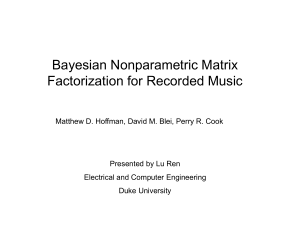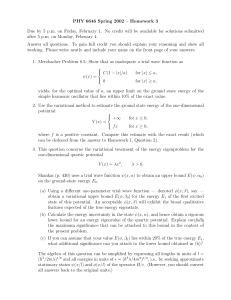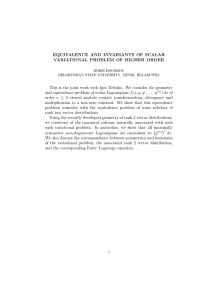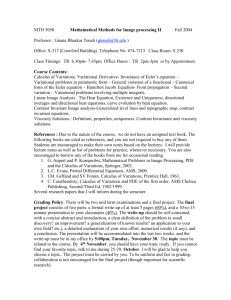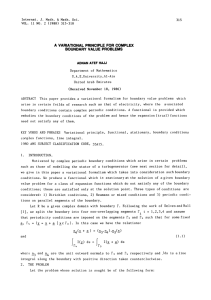MAGNETOHYDRODYNAMIC
advertisement
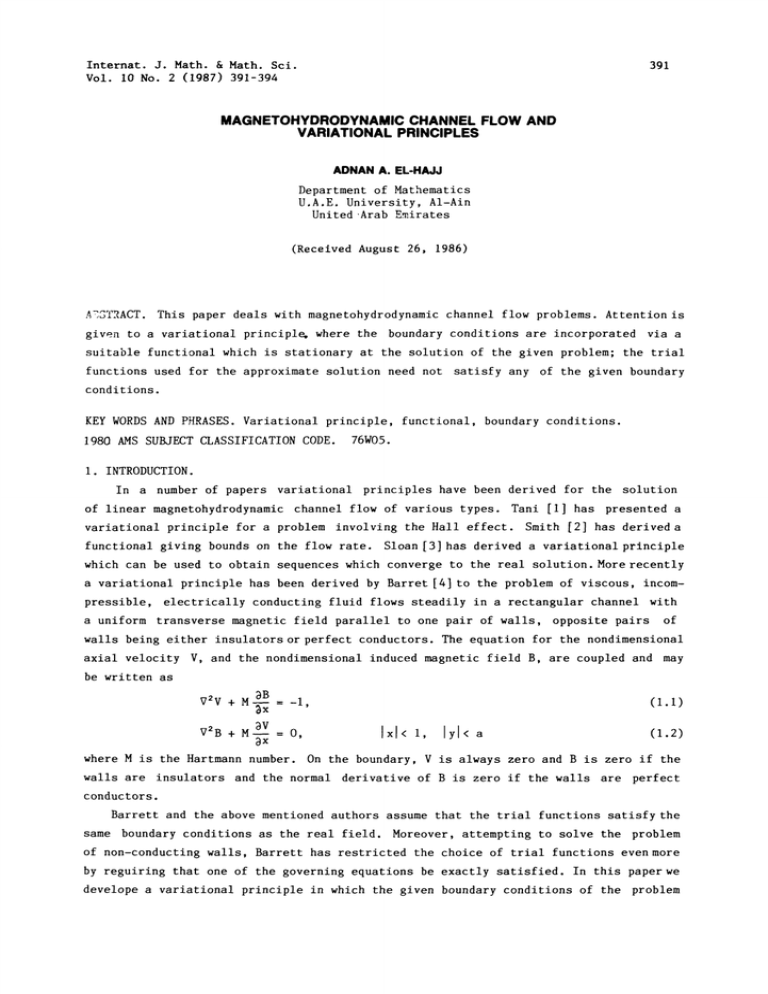
Internat. J. Math. & Math. Sci.
Vol. I0 No. 2 (1987) 391-394
391
MAGNETOHYDRODYNAMIC CHANNEL FLOW AND
VARIATIONAL PRINCIPLES
ADNAN A. EL-HAJJ
Department of Mathematics
U.A.E. University, Ai-Ain
United’Arab Emirates
(Received August 26, 1986)
ADSTRACT. This paper deals with magnetohydrodynamic channel flow problems. Attention
given to a variational principl% where the boundary conditions are incorporated
is
via a
suitable functional which is stationary at the solution of the given problem; the trial
functions used for the approximate solution need not satisfy any of the given boundary
conditions.
KEY WORDS AND PHRASES. Variational principle, functional, boundary conditions.
1980 AMS SUBJECT CLASSIFICATION CODE. 76W05.
I. INTRODUCTION.
In a number of papers variational principles have been derived for the solution
of linear magnetohydrodynamic channel flow of various types. Tani [I] has presented a
variational principle for a problem involving the Hall effect. Smith [2] has deriveda
functional giving bounds on the flow rate.
Sloan [3] has derived a variational principle
which can be used to obtain sequences which converge to the real solution.
a variational principle has been derived by
More recently
Barret [4] to the problem of viscous,
incom-
pressible, electrically conducting fluid flows steadily in a rectangular channel with
a uniform transverse magnetic field parallel to one pair of walls,
opposite pairs
of
walls being either insulators or perfect conductors. The equation for the nondimensional
axial velocity
V, and the nondimensional induced magnetic field B,
are coupled and may
be written as
B
V2V +
M-
-I,
V2B +
M--V8x
O,
(I.i)
Ixl<
i,
lyl<
a
(1.2)
where M is the Hartmann number. On the boundary, V is always zero and B is zero if the
walls are insulators and the normal derivative of B is zero if the walls are perfect
conductors.
Barrett and the above mentioned authors assume that the trial functions satisfy the
Moreover, attempting to solve the problem
same boundary conditions as the real field.
of non-conducting walls, Barrett has restricted the choice of trial functions even more
by reguiring that one of the governing equations be exactly satisfied. In this paper we
develope a variational principle in which the given boundary conditions of the problem
392
A.A. EL-HAJJ
are imposed implicitly via suitable terms in the functional and hence the expansion set
of functions need not satisfy any of them.
THE VARIATIONAL PRINCIPLE.
2.
The variational techrque derived in this
sction, applicable
to a wide range
of
linear non-seif-adjoint problems, is used to derive a stationary principle for a magnet-
In the particular case of (I.I) and (1.2) subject to the
ohydrodynamic channel flow
boundary conditlons V=O and B=O a variational principle is derived by first introducing the folloing adjoint problem of(l.l) and (1.2):
C
(2.1)
-i
V2U
M
aU
V2C
M-
lxl
O,
<l,
where U and C are zero on the boundary. The functional
,
T and
and
lyla
delends
(2.2)
on four variables:
,
,
is
THEOR I. The solution to (I.I), (1.2), (2.1) and (2.2) renders the following functioB, m U and T C
V, B
nal stationary at the solution points
,
J(, 8,
T)
{-V"
Vv-VT. VB+MB/x+MTv/x+u+}dS
_
[{Vu’+TVS’+uV’+8’}
+
S
1+
([ MuT
a
+ [MS
where 8s is the boundary of the region, V
and ds is a boundary element.
PROF.
and (2.2);
-
(2.3)
ds
)dy
denotes differentiation along the normal
Let V and B be the solution of (1.1) and (1.2); U and C the solution of (2.1)
,, ,
Define F,(e)
F(e)
arbitrary functions.
6 and
J(V, B+e, U, C);
J(V+a, B, U, C); F(e)
J(V, B, U+eE, C);
J(V, B, U, C+eE),
F(e)
V, B, U and C if
then the functional J is stationary at
dFi(O)=
O,
i
i, 2, 3, 4.
NOW,
dF1 (0)
de
[-VU
V1 +
S
(UV
-n
a
IMC
]+
C(M--)
VU .n]ds
+
_I
]dS
+
dy
Using Green’s theorem
Isand the fact that
VU" 7i dS
Is
VU
4
IsV
nds
(2.5)
MAGNETOHYDRODYNAMIC CHANNEL FLOW AND VARIATIONAL PRINCIPLES
we get upon
dF(O)
de_
i MC
-I M dS +
C (MT-- dS
x
3x
+
]+* dy
(2 6)
+a
substtuting (4.5) and (2.6)
Is( 7zU_M3C
393
I
)dS
+
in
I
(2.4)’and recalling that
7U. nds +
)s
s
_a
I MC
]+I dy
1 Me
]+ dy
on the boundaryU
0
a
1 7li nds
(2.7)
a
The f.rst .ntegral in (2.7) is equal to zero by (2.1) and it is obvious that the Iane
Integrals cancel one another. Hence, dF,(0)/de --O.
In much the same way,
it can easily be shown that
dFi(O)/de
0 for i
2, 3, 4. Hence.
the functional J is stationary at the solutions of the given problem and its adjoint.
3. MATII SET-lIP.
The variational pr+/-nciple derived in the privous section will now be used to obtain
the defining equations for the approximate solution to the problem of channel flow with
non-conducting walls.
We +/-ntroduce appropriate basis functions--typically, a set of product orthogonal polynom’ials and a global expansion of the solution is made:
N
v(N)(x’Y)
i=l
and
(I)
ai h i (x y);
8(N)(x
(I) h (x y);
1
1
T(N)(x
N
(N)(x,y)
[
i=l
b
N
Y)
[
i--1
N
y)
[
i=l
(2) h (x y)
i
ai
(3.1)
(2)
b
hi(x
Y)
Inserting these expansions into (2.3) and finding the stationary value of the functional
a_(k), k= I, 2
leads to he symmetric block matrix equation for the coefficients
A
S
a(l
B
A
(2)
I, 2
Where for i, j
A
B
fs-qhi
Is
(3.2)
0
N
I3 (hiqhJ
7h’dS +
s
+
hj 7hi)
a
Mh
i
hj/x
dS
I_.
Mh
a
ihj
+I
Q
Is-h.
0
zero vector of appropriate length.
1
nds_
dy
dS
An important feature of our technique is that the basis functions hi(x0y) are not required
to satisfy any of the boundary conditions of the problem; these conditions are imposed
mplicitly by the functional, and are satisfied exactly only at the solution point. We
see Mikhiln [5]), that the set of basis functions
only require, for stability reasons
be a set of product orthogonal polynomials.
394
A.A. EL-HAJJ
To solve (3.2) a numerical technique which reduces the operation count and leads
economic
use of storage will be used in a forthcoming paper
varlatlonal forallsm to produce numerical
results
to
together with the present
for the magnetohydrodynamic channel
flo problem.
REFERENCES
I.
TANI, I. Steady
Flo, of Conducting Fluids in Channels under Transverse Magnetic
Fields, with Considerationof Hall Effect, J. Aero. Sci.29(1962), 297-304.
SMITH, P. Some Extremum Principles lor Pipe Flow in Magnetohydrodynamics, Z. angew.
Math. Phys. 23 (1972), 753-764.
3. SLOAN, D.M. Extremum Principles for Magnetohydrodynamic Channel Flow, Z. anew. Math.
Phys. 24 (1973), 689-698.
4. BARRETT, K.E. Minimax Principle for Magnetohydrodynamic Channel Flow, ZAMP27 (1976),
613-619.
5. MIKHILN, S.C. The Numerical Performance of Variational Methods, Noordhoff, Amsterdam,
2.
1971.



